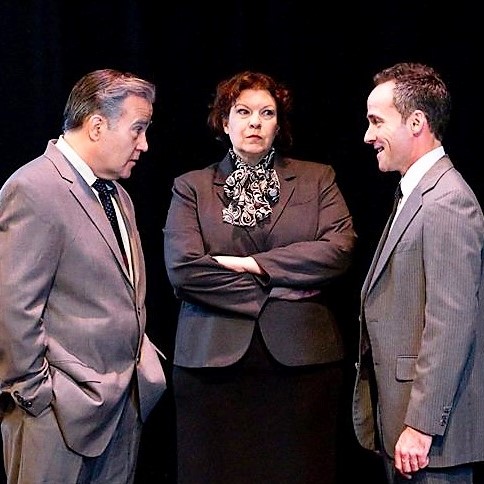
Quantum performances and direction
power Tampa Rep’s Copenhagen
Michael Frayn’s historical drama runs through Jan. 20 at USF Studio 120.
BY KEVEN RENKEN | Jan. 15, 2019
There is undoubtedly a fraction of the theater-going public for whom physics would be an undeniably sexy subject. Conversely, there are those that would rather pass a kidney stone than watch anything where physics is a topic of conversation.
Most of us, however, are those huddled masses in the middle, yearning to see thematically challenging theater, with top-notch professional acting and crisp, economical direction. If that describes you, then Tampa Repertory Theatre’s latest production is just the thing for you.
Copenhagen, which runs through Jan. 20 at USF Studio 120, begins with a decades-old question – why did Werner Heisenberg, who worked for the German government and about to head the German Nuclear Weapon Project, go to visit Niels Bohr and his wife Margrethe, non-Nazi sympathizers, in 1941? Certainly they were once colleagues (or at least mentor and mentee), but no one else was privy to what was discussed during the very private visit.
In the expert hands of playwright Michael Frayn (who is perhaps best known stateside for the farce Noises Off), the speculation takes on the voices of the people involved, layering on the details as they remember them in different versions of the story.
To add to the complexity, the characters are looking back from the afterlife, where the clarity of hindsight collides with the fogginess of memory to create some version of the truth. In the end, Heisenberg may not have directly said what he wanted (“I carry my surveillance around like an infectious disease” lets us know that he is being watched), though much information has been conveyed among the three.
Director Emilia Sargent keeps things brisk for a play that is so much about the words and character interaction. She also, quite wisely, keeps the minimalism, which is a true strength of the show – three characters with three chairs, warily circling each other on stage. Her traffic patterns are a joy, like mathematical formulas of fusion and fission as the characters come together and crack apart. Lighting and sound seamlessly combine to take the audience and the actors backward and forward in time (particularly in a heartbreaking sequence where the Bohrs relive the drowning of their son).
But a play like this lives or dies on the performances of its actors, and that is where this production really shines. In a cast with no weak links, Christopher Marshall is the true standout. Perhaps because he has the most complicated arc to play – tortured by his role in the war and struggling to find a way to stay principled – Marshall’s Heisenberg is a mercurial study of emotions tumbling on top of each other.
However, Ned Averill-Snell and Ami Sallee are Marshall’s equal every step along the way. Averill-Snell’s Bohr is a fascinating blend of gruffness, outrage and unfettered affection for the younger man. His face, when he realizes what Heisenberg is trying to say without saying it outright, is a highlight among many. Sallee, though often on the sideline observing – “They’re so busy avoiding each other’s eyes they scarcely see each other at all” is how she describes the other two at one point – still manages to make some of the pithiest comments in the script.
Frayn, excellent wordsmith that he is, does nothing to make the theoretical portion of the evening more palatable for the aforementioned huddled masses, and that language, a slog from the very beginning, threatens to overwhelm by evening’s end.
“It was too much work,” my companion said after it was all over. To my mind, though, it was just the right amount of work. After all, an involving story and production can be a very sexy thing indeed – and well worth the effort if the theater-going public wants to give it half a chance.


